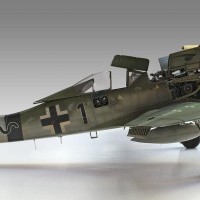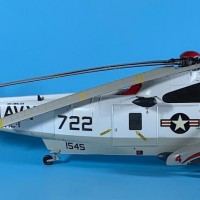The Mil Mi-6 ‘Hook’, a truly record-breaking giant!
The heavy transport helicopter presented here not only occupies a special place among Soviet designs, but also stands out among all rotorcraft designs of its time. From the time of its first flight in June 1957, this giant was the largest helicopter ever built in series in the world for 10 years. With an overall length of 42 metres, the Mi-6 towered far above any comparable aircraft; the enormous main rotor alone measured an impressive 35 metres in diameter.
The Mil Mi-6 also made history with its propulsion system: it was the first Soviet helicopter to use turbines for power: two Solovyov D-25W units, each with a shaft power of 5500 hp, provided enough force to accelerate the Mi-6, which had a maximum take-off weight of 42,000 kg, to a record speed of 340 km/h. This made the Mi-6 the undisputed world champion. The Mi-6 was thus undisputedly the fastest helicopter in the world.
In order to achieve this speed, which was unique for a rotorcraft, they not only relied on the raw power of two turbines, but also utilised aerodynamics in a somewhat more elegant way. This was to give the Mi-6 a highly recognisable appearance: two wings with a large angle of attack could be mounted on the upper fuselage of the Mi-6, increasing lift by up to 20% in cruise flight. The energy gained in this way could be converted into speed.
While the Mi-6 was the first in many areas, it was the last to have a special feature: remarkably, the tail rotor blades were still made of wood, a unique solution, especially for heavy large helicopters.
Even if you look at the carrying capacity of the Mi-6, you can't avoid superlatives - after all, 17 world records were set with it! Two of them are mentioned here. Over 20,000 kg of internal payload and the ability to hook up an additional 9,000 kg as an external load secured first place for the Mi-6, and it still holds the FAI record for the fastest average speed flown with a 5000 kg load over a distance of 1,000 kilometres: as far as I know, the 284 km/h have not yet been surpassed.
With such potential, it is not surprising that the Mil Mi-6 ‘Hook' was widely used in large numbers and deployed in numerous sub-versions and variants. The spectrum of the large helicopter used for both military and civilian purposes ranged from combat zone transporter, flying command post and military and civilian heavy load transporter to use in disaster relief and as a fire-fighting aircraft to service as a ‘flying crane'. This was an operational role in which the Mi-6 particularly excelled: at over 20 tonnes, it could lift more weight than the empty weight of the largest helicopter in the West, the CH-61 Skycrane!
A wide range of different loads could be taken on board via the clamshells that could be opened across the entire width of the fuselage. There was room for up to 65 fully equipped infantrymen as well as 41 wounded on stretchers together with the necessary infrastructure. Bulky cargo such as the PT-76 armoured reconnaissance vehicle or the FROG-7 short-range missile system could also be transported on the Mi-6.
The Mi-6 was not only flown in the former Soviet Union, but was also exported to neighbouring countries. The ‘Hook' was used in countries such as Egypt, Algeria, Iraq, Pakistan, China, Peru and Vietnam. The North Vietnamese used the Mi-6 during the years of the American Vietnam War, for example, to transport their MiG 17 or MiG 19 to the combat areas or to the repair yards - as an external load on the Hook - the Mil Mi-6 thus lived up to its NATO code name ‘Hook'.
Between 1959 and 1980, a total of 926 examples of the Mi-6/Mi-22 were produced in numerous variants and versions. The decommissioning in Russia took place in 2002: the wooden rear propellers had finally reached the end of their service life.
The inspiration for the model
The model shown here depicts an Mi-6 in a variant of which only a few examples were produced: the Mi-6VKP was designed as a flying command post. This explains the numerous antenna and communication systems that characterise its appearance. However, in order to be used as a command post, the helicopter had to be landed, so the term ‘flying' is misleading and should actually be replaced by ‘airmobile'. A truly flying command post was only realised with a subsequent variant, the Mi-6AYa/VzPU, which also became known as the Mi-22.
Kit and building process
This provides a good transition to the modelling aspects: the Mi-6 was built as part of a parallel double project. The second ‘Hook' was realised as one of the aforementioned Mi-22s.
It seems astonishing to me that such an important helicopter as the Mi-6, which can hardly be overlooked not only because of its sheer size but also because of its historical significance, is actually only offered as a plastic kit by a single manufacturer! This task has been taken on by the manufacturer Amodel, who produced the first Mi-6 in 1:72 scale in 2005 using new moulds.
Anyone familiar with Amodel will know that although the parts here are cleverly and ambitiously designed, their dubious accuracy of fit and what can only be described as ‘rough' mould casting can sometimes put the skill and patience of the model builder to the test. Light and shade are always very close together here.
I have decided not to overload the articles on the two models with content or even make the second one a repetition of the first. So I have focussed my story here on the type and operational history of the Mi-6 helicopter family, while the following second article on the Mi-6AYa/VzPU (or Mi-22) will mainly deal with the kit and the experiences I was able to make with it during the course of the project.
And there really is a lot to report here - I can already announce that with a clear conscience!






























Both are wonderful, Roland! Exceptional job on these truly challenging kits! Congratulations!
Thank you for your words, Spiros!
Nicely done, Roland. I always like your photos with backgrounds. And of course your builds...
I feel motivated- thank you!
Excellent work on those heavy helicopters, Roland @rosachsenhofer
Appreciated- thank you!
Turned out well considering most if not all A-model Models are putty/CA glue monsters. It has the Mil "look".
Thank you for your comment, Lee!
Wow - that was a tough-looking kit, but you really make a silk purse out of that sow's ear! Beautiful!
Thank you Greg- motivating!
Well done Roland, both looking good, nice history.
Thank you for your words!
A model for the 'Experten'. I just watch the pics of this great model 🙂
Thank you Michiel!